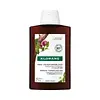Klorane Strengthening Shampoo With Quinine And Edelweiss Versus Dove Men+Care Fortifying Strengthening Shampoo
What's inside
What's inside
 Key Ingredients
Key Ingredients

 Benefits
Benefits

 Concerns
Concerns

 Ingredients Side-by-side
Ingredients Side-by-side

Water
Skin ConditioningDisodium Laureth Sulfosuccinate
CleansingPEG-120 Methyl Glucose Dioleate
EmulsifyingLauryl Betaine
CleansingLaureth-3
EmulsifyingMaleic Acid
BufferingPEG-40 Hydrogenated Castor Oil
EmulsifyingCinchona Succirubra Bark Extract
Skin ConditioningLeontopodium Alpinum Flower/Leaf Extract
Skin ConditioningCaffeine
Skin ConditioningBiotin
AntiseborrhoeicNiacinamide
SmoothingPanthenol
Skin ConditioningAlcohol
AntimicrobialCI 42090
Cosmetic ColorantCaprylyl Glycol
EmollientCitric Acid
BufferingParfum
MaskingGlycerin
HumectantCI 42053
Cosmetic ColorantPantolactone
HumectantPolyquaternium-22
Potassium Sorbate
PreservativePyridoxine Hcl
Skin ConditioningCI 17200
Cosmetic ColorantSodium Benzoate
MaskingSodium Chloride
MaskingTocopherol
AntioxidantCI 15985
Cosmetic ColorantWater, Disodium Laureth Sulfosuccinate, PEG-120 Methyl Glucose Dioleate, Lauryl Betaine, Laureth-3, Maleic Acid, PEG-40 Hydrogenated Castor Oil, Cinchona Succirubra Bark Extract, Leontopodium Alpinum Flower/Leaf Extract, Caffeine, Biotin, Niacinamide, Panthenol, Alcohol, CI 42090, Caprylyl Glycol, Citric Acid, Parfum, Glycerin, CI 42053, Pantolactone, Polyquaternium-22, Potassium Sorbate, Pyridoxine Hcl, CI 17200, Sodium Benzoate, Sodium Chloride, Tocopherol, CI 15985
Water
Skin ConditioningSodium Laureth Sulfate
CleansingCocamidopropyl Betaine
CleansingParfum
MaskingDimethiconol
EmollientGlycol Distearate
EmollientSodium Benzoate
MaskingCitric Acid
BufferingCarbomer
Emulsion StabilisingCocamide Mea
EmulsifyingTea-Dodecylbenzenesulfonate
CleansingGuar Hydroxypropyltrimonium Chloride
Skin ConditioningDisodium EDTA
Trideceth-10
CleansingCyclotetrasiloxane
EmollientPhenoxyethanol
PreservativeLysine Hcl
Skin ConditioningCaffeine
Skin ConditioningClimbazole
AntimicrobialPPG-9
Skin ConditioningZinc Gluconate
Skin ConditioningIodopropynyl Butylcarbamate
PreservativeMethylchloroisothiazolinone
PreservativeMethylisothiazolinone
PreservativeWater, Sodium Laureth Sulfate, Cocamidopropyl Betaine, Parfum, Dimethiconol, Glycol Distearate, Sodium Benzoate, Citric Acid, Carbomer, Cocamide Mea, Tea-Dodecylbenzenesulfonate, Guar Hydroxypropyltrimonium Chloride, Disodium EDTA, Trideceth-10, Cyclotetrasiloxane, Phenoxyethanol, Lysine Hcl, Caffeine, Climbazole, PPG-9, Zinc Gluconate, Iodopropynyl Butylcarbamate, Methylchloroisothiazolinone, Methylisothiazolinone
Ingredients Explained
These ingredients are found in both products.
Ingredients higher up in an ingredient list are typically present in a larger amount.
Caffeine is most associated with coffee, tea, and cacao. In skincare, it helps with calming inflammation and is rich in antioxidants.
While caffeine is used to treat cellulite and and dark circles, further studies are needed to prove this. It has been believed to help with these skin conditions due to its ability to dilate blood vessels and increase blood flow.
Some studies are looking into caffeine's ability to protect against UV rays.
Learn more about CaffeineCitric Acid is an alpha hydroxy acid (AHA) naturally found in citrus fruits like oranges, lemons, and limes.
Like other AHAs, citric acid can exfoliate skin by breaking down the bonds that hold dead skin cells together. This helps reveal smoother and brighter skin underneath.
However, this exfoliating effect only happens at high concentrations (20%) which can be hard to find in cosmetic products.
Due to this, citric acid is usually included in small amounts as a pH adjuster. This helps keep products slightly more acidic and compatible with skin's natural pH.
In skincare formulas, citric acid can:
While it can provide some skin benefits, research shows lactic acid and glycolic acid are generally more effective and less irritating exfoliants.
Most citric acid used in skincare today is made by fermenting sugars (usually from molasses). This synthetic version is identical to the natural citrus form but easier to stabilize and use in formulations.
Read more about some other popular AHA's here:
Learn more about Citric AcidParfum is a catch-all term for an ingredient or more that is used to give a scent to products.
Also called "fragrance", this ingredient can be a blend of hundreds of chemicals or plant oils. This means every product with "fragrance" or "parfum" in the ingredients list is a different mixture.
For instance, Habanolide is a proprietary trade name for a specific aroma chemical. When used as a fragrance ingredient in cosmetics, most aroma chemicals fall under the broad labeling category of “FRAGRANCE” or “PARFUM” according to EU and US regulations.
The term 'parfum' or 'fragrance' is not regulated in many countries. In many cases, it is up to the brand to define this term.
For instance, many brands choose to label themselves as "fragrance-free" because they are not using synthetic fragrances. However, their products may still contain ingredients such as essential oils that are considered a fragrance by INCI standards.
One example is Calendula flower extract. Calendula is an essential oil that still imparts a scent or 'fragrance'.
Depending on the blend, the ingredients in the mixture can cause allergies and sensitivities on the skin. Some ingredients that are known EU allergens include linalool and citronellol.
Parfum can also be used to mask or cover an unpleasant scent.
The bottom line is: not all fragrances/parfum/ingredients are created equally. If you are worried about fragrances, we recommend taking a closer look at an ingredient. And of course, we always recommend speaking with a professional.
Learn more about ParfumSodium Benzoate is a preservative. It's used in both cosmetic and food products to inhibit the growth of mold and bacteria. It is typically produced synthetically.
Both the US FDA and EU Health Committee have approved the use of sodium benzoate. In the US, levels of 0.1% (of the total product) are allowed.
Sodium benzoate works as a preservative by inhibiting the growth of bacteria inside of cells. It prevents the cell from fermenting a type of sugar using an enzyme called phosphofructokinase.
It is the salt of benzoic acid. Foods containing sodium benzoate include soda, salad dressings, condiments, fruit juices, wines, and snack foods.
Studies for using ascorbic acid and sodium benzoate in cosmetics are lacking, especially in skincare routines with multiple steps.
We always recommend speaking with a professional, such as a dermatologist, if you have any concerns.
Learn more about Sodium BenzoateWater. It's the most common cosmetic ingredient of all. You'll usually see it at the top of ingredient lists, meaning that it makes up the largest part of the product.
So why is it so popular? Water most often acts as a solvent - this means that it helps dissolve other ingredients into the formulation.
You'll also recognize water as that liquid we all need to stay alive. If you see this, drink a glass of water. Stay hydrated!
Learn more about Water